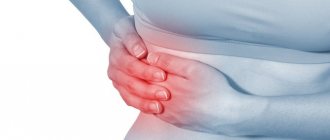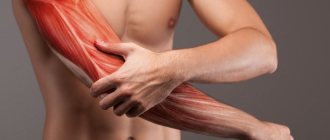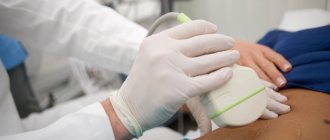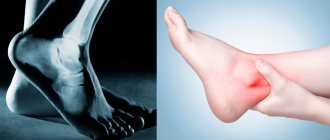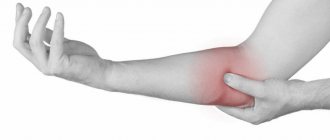Intercostal neuralgia
- the most common cause of chest pain and the biggest medical “deceiver”, since the clinical manifestations of this disease are similar to the symptoms of diseases, possibly, of all organs of the chest and abdominal cavity. Neuralgia is translated from the Greek “neuron” - nerve and “algos” - pain. The development of pathology occurs when the intercostal nerves are irritated and pinched. Severe pain spreads along the nerves to the spinal cord and then to the brain and is accompanied by other unpleasant symptoms, such as a burning sensation, numbness, and crawling. Intercostal neuralgia cannot be called an independent disease, because very often its development occurs against the background of diseases such as spinal osteochondrosis, scoliosis, vertebral displacement, and various tumor diseases. Intercostal neuralgia is a concomitant symptom of other serious pathologies and is recorded more often among older people, which is associated with age-related changes. Clinical symptoms of intercostal neuralgia are also possible in young people leading a sedentary lifestyle. Neuralgia practically does not occur in children.
Types of intercostal neuralgia
Typically, intercostal neuralgia affects one intercostal nerve on one side of the body. But sometimes the disease forms a wider pathological zone, occupying two or three intercostal spaces, and several nerve roots on one side are affected.
In addition to unilateral lesions, there is bilateral intercostal neuralgia, which can be caused by diseases with a pronounced decrease in immunity, such as herpetic neuralgia caused by HIV infection in the AIDS stage, or other diseases, for example, radiation sickness.
Diagnosis of the pathological condition
With osteochondrosis, pain in the ribs is periodic, sometimes worsening - usually in the evening and at night, and after a night's rest it subsides. Since the thoracic part of the spine is its most sedentary part, the pain is not as pronounced as with degenerative changes in other areas. It can intensify when breathing, coughing, sighing, but still the vagueness of its manifestations makes patients suspect that they have completely different diseases.
Therefore, it is very important to conduct a thorough differential diagnosis with other pathologies using various types of research:
- X-ray of the chest and lungs, heart, spine - in several projections;
- Computed tomography or nuclear magnetic resonance scanning of the mediastinal organs and the entire chest, including spinal structures;
- Electrocardiography;
- Electromyography;
- Echocardiography;
- Examination of the vital capacity of the lungs, listening to breathing, sputum analysis and other techniques to identify respiratory pathologies;
- Dopplerography of mediastinal vessels;
- General and biochemical tests, etc.
Step by step, in a clinical setting, it is necessary to exclude the most life-threatening conditions, while simultaneously alleviating the patient’s condition with symptomatic means.
Symptoms and signs of the disease
The main manifestation of intercostal neuralgia is acute and burning pain along the intercostal nerves, sometimes intensifying in paroxysms, especially with movement, with turns of the body, with deep breathing, coughing and sneezing. When feeling and during palpation of the spine and intercostal spaces, their sharply increased sensitivity and pain are recorded, corresponding to the affected segment. The pain that occurs with intercostal neuralgia is constant, encircling in nature, forcing the patient to take a forced position, in which the patient bends the body in the healthy direction, trying to maintain it. The pain syndrome lasts from several hours to several days. Sometimes there is a feeling of numbness and a sensation of “pins and needles” in the affected area.
How to distinguish intercostal neuralgia from heart pathologies?
Symptoms of intercostal neuralgia, often simulating lesions of the cardiovascular system, can be mistakenly regarded as a heart attack. For example, pain in the heart area radiating to the left shoulder blade is a sign that can only be associated with the presence of wide branches of nerves in the intercostal space.
You need to know that with pain felt in the retrosternal region associated with a disturbance in the functioning of the heart, there are necessarily changes in blood pressure and pulse rhythm. Such a connection is absent with intercostal neuralgia, and the pain is of a girdling nature. Neuralgia pain is not relieved by nitroglycerin. In addition, changes in body position during heart disease will not affect the nature of the pain. But if the intercostal nerves are pinched, the pain will worsen with sudden movement, coughing, sneezing, or deep breathing.
At the same time, you need to know that myocardial infarction with extensive damage to the heart muscle can cause pain, which increases with movement and does not decrease when taking heart medications, which makes it difficult to diagnose the disease.
In some cases, the nature of the pain resembles the pain associated with renal colic. This occurs when the nerves of the lower ribs are affected, when there is a sudden sharp, cramping pain in the lumbar region, which radiates to the leg or groin area.
If chest pain occurs, which can be one of the symptoms of a number of life-threatening, serious diseases, it is certainly necessary to consult a doctor. Therefore, in no case should you prescribe treatment for yourself; you should not hesitate, but you should immediately seek medical help.
Ways to identify the causes of girdle pain
Modern diagnostic methods make it possible to determine the cause of pain localized in the back and under the ribs. When patients who have experienced back pain come to the Yusupov Hospital, the existing symptoms are studied, after which an examination is prescribed.
The main diagnostic measures for back pain are:
- urine and blood tests. The Yusupov Hospital has its own laboratory, so the results are delivered to the attending physician in the shortest possible time;
- Ultrasound of internal organs to detect pathological changes;
- examination of substances discharged from the lungs to exclude diseases of the respiratory system;
- X-ray of the upper limbs and lungs;
- gastroscopy.
Patients may be referred for additional consultation to other specialists at the Yusupov Hospital, a cardiologist, a neurologist, or a rheumatologist. Self-medication for back pain can provoke serious consequences, since without special equipment and knowledge it is impossible to accurately identify the cause of the disease and its manifestations.
Diagnostics
The diagnosis of intercostal neuralgia is made by a doctor based on the patient’s complaints, medical history, after a thorough examination and clarification of the etiology of chest pain. The disease is characterized by possible redness or blanching of the skin in the affected nerve area, and upon palpation there is pain along the affected nerve. With this disease, a mandatory examination of the chest organs is necessary in order to exclude pneumonia, pleurisy, and pneumothorax. An additional examination of the heart and an ECG is necessary if the pain is localized on the left side of the body, to exclude a number of severe heart diseases.
In order to exclude pathologies of the spine, the doctor may prescribe radiography, MRI, CT and myelography, which determines the condition of the nerve roots, and ultrasound.
Get a free consultation by phone
Possible causes of rib pain
Most often, patients believe that pain occurs in the rib bones, although in fact the discomfort may appear due to muscle spasms or compression of the nerve roots. Main reasons
rib pain:
- pathologies of nerves and muscles;
- excessive physical and psychological stress;
- trauma, rib tumors, Tietze syndrome;
- diseases of the spine (spondylosis, arthrosis, osteochondrosis, hernias and protrusions);
- pathologies of the pleura, including tumors.
Soreness of the rib bones is a relatively rare phenomenon that occurs in severe bone diseases or injuries (fractures). If pain in the ribs appears after a bruise or fall, or a blow to this area, medical attention is required immediately, because a broken rib bone can damage the heart or lungs.
Often discomfort in the chest area accompanies colds or pneumonia. This symptom should be reported to your doctor, as it can be not only muscle spasms due to coughing, but also the consequences of deterioration of the lungs, bronchi or pleura.
Treatment of intercostal neuralgia
Treatment of a disease such as intercostal neuralgia is aimed, first of all, at eliminating the causes that cause it, relieving pain and alleviating the patient’s condition. During the acute period of the disease, it is recommended to adhere to bed rest. It is advisable for the patient to lie on a hard, flat surface, preferably on an orthopedic mattress, or with a shield under the mattress.
Light, dry heat will help alleviate the patient’s condition with intercostal neuralgia; for this you can use sand heated in bags, an electric heating pad, mustard plasters, pepper plaster on the painful area, or a woolen scarf. The patient should avoid sudden movements, bending and turning the body, prolonged sitting, and heavy lifting.
Wearing a corset helps, but not for long, to avoid the development of muscle weakness.
Drug treatment
To treat intercostal neuralgia, it is necessary to carry out active anti-inflammatory measures. When treating intercostal neuralgia, the patient may be prescribed drug treatment with drugs from the following groups:
- anti-inflammatory non-steroidal drugs that relieve pain and have a pronounced anti-inflammatory effect;
- muscle relaxants, reducing muscle spasms;
- calming nervous system, herbal remedies;
- B vitamins - milgamma, neurorubin, neurobion and other drugs that restore damaged nerve structures and improve the passage of impulses.
For local treatment, the doctor may prescribe ointments and gels with NSAIDs - fastum-gel, dolobene and others. Preparations are also prescribed - solutions and ointments that do not contain non-steroidal anti-inflammatory drugs, but have
analgesic effect - finalgon, capsicam, menovazin.
There is also a relatively new dosage form for the treatment of this pathology - transdermal patches, which have a pronounced anti-inflammatory and analgesic effect.
Non-drug treatment
After acute pain has been relieved, non-drug treatment methods can help quickly restore the functions of the affected areas, such as:
- therapeutic massage that provides muscle relaxation, relieves pain, improves metabolic processes in the paravertebral muscles, and reduces swelling;
- vacuum therapy – cupping massage to further enhance soft tissue drainage;
- manual therapy to normalize intervertebral connections, eliminate pinched nerves;
- Exercise therapy to strengthen the muscular corset of the spinal column;
- physiotherapy: electrophoresis, phonophoresis, electrical myostimulation of muscles, magnetic therapy, laser therapy;
- acupuncture;
- hirudotherapy.
Intercostal neuralgia, which often occurs during pregnancy, is a fairly serious problem that requires increased attention to the patient. The cause of intercostal neuralgia in the second half of pregnancy is an increase in pressure caused by a restructuring of the usual arrangement of organs on the chest, ribs, intercostal spaces, and nerves. The doctor must competently select such an individual complex treatment regimen in order to avoid complications for the mother and child. Properly selected and timely treatment of intercostal neuralgia leads to a fairly rapid recovery and does not cause long-term problems for a pregnant woman.
Treatment with folk remedies
To alleviate the patient's condition with intercostal neuralgia, traditional medicine methods are also used, which have a good effect, in combination with the treatment prescribed by the doctor.
Ointments based on snake and bee venom have long been known; after rubbing them into the affected area, the application site must be insulated with a woolen scarf. It will also help to treat intercostal neuralgia using a pepper patch, before using which you need to wipe the skin with an alcohol solution or cologne and then wipe it dry. The patch should be removed when intense burning occurs.
An effective remedy is rubbing an alcohol solution of mumiyo into diseased areas and taking 20 grams of mumiyo orally before meals.
It must be remembered that for a successful recovery it is important not only to relieve pain, but much more important is to identify the cause of the disease and its comprehensive treatment.
Treatment
Help before diagnosis
If the pain syndrome is minor and the general condition is satisfactory, it is recommended to limit physical activity for several days and use local anesthetics, warming and anti-inflammatory drugs. If the skin is damaged, ointments and gels should not be applied. If you feel weak, have a fever, or experience severe pain, shortness of breath, cough, or hemoptysis, you should urgently seek medical help.
Conservative therapy
The conservative treatment plan is determined by the nature of the pathology. In most cases, rest is recommended, breathing exercises and physiotherapy are prescribed. In some cases, massage and manual therapy are indicated. Drug therapy may include:
- Analgesics
. For moderate pain, tablets are used; for severe pain, medications are administered intramuscularly. In the later stages of cancer, narcotic drugs are required. - Antibiotics
. For pleurisy, purulent periostitis, osteomyelitis, antibiotic therapy is indicated. First, broad-spectrum drugs are used, then the treatment regimen is adjusted taking into account the sensitivity of the pathogen. - Hormonal agents
. Pain due to intercostal neuralgia and Tietze syndrome is successfully eliminated by blockade with corticosteroids. Blockades are performed when other methods are ineffective; the course includes no more than 3 injections of the drug. - Cytostatics
. Medicines are prescribed for malignant tumors, destroy cancer cells, and slow down the growth of tumors. They can be used as monotherapy or a combination of several agents.
Complications
The insidiousness of intercostal neuralgia is that its symptoms can be confused with many other diseases. Sometimes the patient is in no hurry to get an appointment and begins to treat intercostal neuralgia with ointments, tablets or herbs. For any form of the disease, even mild, the patient must be examined by a doctor. In no case should you independently diagnose yourself and prescribe treatment - the lack of medical intervention for serious diseases mistakenly mistaken for intercostal neuralgia can cost the patient’s life.
After identifying the cause of the disease, the doctor will prescribe adequate treatment to minimize the risk of complications.
The main complication of intercostal neuralgia is the transition of the disease to a chronic form with frequent exacerbations.
Treatment for rib pain
The treatment plan is developed depending on the diagnosis and the reasons for the development of the pathology. For the treatment of cervicothoracic osteochondrosis and other pathologies of the spine and joints, anti-inflammatory and painkillers, antispasmodics, chondroprotectors and muscle relaxants are prescribed. Courses of massage, physiotherapy, manual therapy or osteopathy may also be prescribed.
Massage helps relieve excessive tension and pain, it has a warming and relaxing effect. However, this procedure is unacceptable for acute injuries, colds and cancer.
Physiotherapy and acupuncture help eliminate pain and muscle hypertonicity, normalize metabolic processes, eliminate inflammatory foci, restore damaged tissue and increase local immunity. To strengthen the muscle corset and healthy distribution of static load, physical therapy is necessary, which allows you to relieve spasms, increase muscle mass and correct posture. During treatment and in the future for prevention, it is necessary to follow a daily routine and get enough rest, wear comfortable shoes, avoid hypothermia and eat right.
Chronic liver diseases in humans
Chronic liver pathologies under the influence of factors - poor nutrition, violation of doctor's recommendations, pregnancy, etc. tend to worsen, which leads to the appearance of a characteristic clinic.
Chronic hepatitis
This is inflammation in the liver, which leads to fibrotic transformations and necrotic changes in cells and tissues, while there is no disruption of the structure of the lobules. Signs of the disease are determined by the degree of damage to the gland and the type of hepatitis.
As the disease progresses, symptoms appear:
- Increased gas formation.
- Decreased appetite.
- Sleep disturbance.
- Headache.
- Loss of body weight.
- Jaundice.
- Periodic pain in the right side.
- Pain on the left side due to the enlargement of the spleen.
- Skin itching.
Based on palpation, the doctor diagnoses diffuse hepatomegaly or an increase in only one lobe, increased liver density.
Fatty degeneration
Fatty liver is an independent syndrome or a secondary one, as a result of which lipid compounds accumulate in the liver tissues.
According to statistics, the disease is most often diagnosed in obese women. In 60-70% of pictures there are no symptoms.
Obvious symptoms of disease progression:
- Abdominal discomfort.
- Aching pain in the right side (mild).
- Hepatomegaly, when touching the right side it hurts.
In some cases, fatty liver is accompanied by dyspeptic disorders and jaundice.
Cirrhotic lesion
Cirrhosis is a disease in which full-fledged liver tissue degenerates into fibrous connective structures. The severity of the clinic is based on the degree of damage to the gland and the activity of cirrhotic processes. At the initial stage, manifestations are minimal, there is no pain.
Over time, discomfort appears under the ribs, digestion is disrupted, and the temperature increases to the level of low-grade fever. As the pain progresses, it intensifies and radiates to different parts of the abdomen and back; jaundice is observed, characteristic signs are redness of the palms, transformation of the nail plates, spider veins on the body.
Tumor neoplasms
Neoplasms of benign (cysts, hemangiomas) and malignant nature (primary, secondary cancer) in the liver do not show symptoms in the initial stages. As the tumor grows, the capsule stretches, which leads to pain.
It can be different - the pain is dull, aching, bursting, sharp. Localization is the right side, irradiation is to the stomach, to the right side under the ribs, to the back, shoulder blade and shoulder. Painful sensations initially appear periodically, but over time they become constant.
